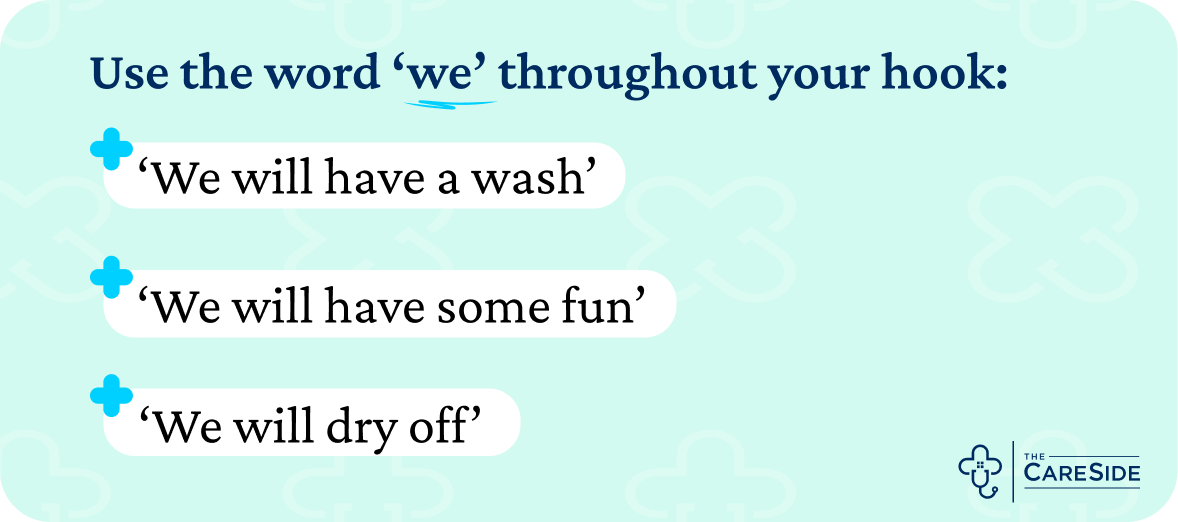Showering someone with dementia can be challenging.
In fact, it’s one of the most common frustrations we hear from caregivers and loved ones who are caring for people living with Alzheimer’s and dementia.
On one hand, we don’t want to force anyone we’re caring for to do something they don’t want to do.
On the other hand, though, it’s our responsibility to help them maintain their hygiene and overall health.
As you probably know, this process can be much more complicated than simply convincing someone to take a shower. Bathing a person living with dementia often requires nuance, negotiation, and a thoughtful plan.
Here are five steps to help you navigate the struggle that often accompanies showering someone with dementia.
1. Have a Plan
A plan can make things easier for everyone.
Someone with dementia might be afraid of bathing, and the first step to circumvent that fear could be to implement his or her lifelong bathing habits. In other words: develop a plan.
Have they always showered in the morning? Or did they prefer to bathe at night time before bed?
Did they like playing music while they bathed?
Was the lighting usually bright, or did they prefer the bathroom a bit dimmer?
Replicating the bathroom scene they’ve grown accustomed to makes the process feel familiar and safe. As part of the pre-showering plan, make sure you have everything ready to go—soap, shampoo, washcloths, and towels—so there’s no need to break momentum once things get moving.
2. Stop Reasoning
Using too many words while trying to communicate with someone living with dementia can cause frustration. A person with dementia might struggle to remember what was said just a few minutes ago, so lengthy explanations about their hygiene won’t land. [Related: Reminisce Therapy for People Living with Dementia]
Try this instead: Approach them slowly, get their attention, and smile. When they smile back, extend your hand (palm-up) and wait for them to take it. Your role here is to be a guide, and the goal with this initial step is to get your loved one moving in the right direction. If they ask “Where are we going?” you can respond with something banal and extremely brief—five words or less. A simple response like “To have fun” is often a good option.
Regardless of the exact conversation, it’s important that you remain matter-of-fact about bathing. Be gentle and respectful, of course, but also make it clear:
“It’s time for a shower now, and here’s our plan.”
3. Warm Up the Bathroom
Particularly on winter mornings, trying to convince someone to remove their clothes while standing in a cold bathroom is really an exercise in futility.
If the bathroom has a heating function in the light or ventilation unit, be sure to turn it on for a few minutes so the bathroom has a chance to warm up. In the absence of a heating unit, try this: turn the water on in the shower and adjust it to the temperature you’d choose for a comfortable shower. Shut the door, and in a few moments, the bathroom should be toasty and inviting.
4. Have a Hook
Showering someone with dementia requires loads of positive reinforcement. As you guide them, you can utilize simple briberies to build and maintain momentum:
“Okay Mum/Dad, let’s have a nice wash, and then I’ll get you a [insert favorite food here] and a cup of tea. Then we’ll go out and have some fun.”
They might push back with a response like, “I don’t want to have fun,” but either way—the focus now is on the fun and not the shower. Try to keep the focus on the food or the reward that’s waiting.
Additionally, be sure to use the word “we” throughout your hook: “We will have a wash” and “We will have some fun.” That sort of language reassures your loved one that you are on their side every step of the way, not to mention, it reinforces your own positive attitude for accomplishing your goal.
5. Check the Water
Many people living with dementia don’t like the water and might even be afraid of it. Their “internal thermostat” may not function properly anymore, and it’s common for someone with dementia or Alzheimer’s to have an altered perception of hot and cold.
Plus, running water might not feel the same to them as it does to you.
Think about it: in a shower, they might feel something hitting their head from above but they can’t see what it is. That could be pretty scary. [Related: Anxiety in Older Adults]
For that reason, be sure to guide your loved one into the shower from the side so the water doesn’t hit their head directly. Instruct them to hold their hand out to feel the water and adjust to the temperature. (Note: Handheld shower heads simplify this process.)
After that initial adjustment, hand them soap and a washcloth and encourage them to start washing. Long-term memory often kicks in at this stage and they start cleaning themselves—provide encouragement and resist the urge to take control unless you have no choice. If necessary, you can also lay out items in the appropriate sequence of use: soap, face scrub, wash cloth, and eventually, a towel and clean clothes.
The point is to allow your loved one to do as much as they can on their own without your intervention.
Summary
Knowing how to get someone with dementia to shower isn’t a set-in-stone process, and there’s no absolute right way that will work for everyone. It might require some trial and error, but if you follow some version of these steps and adjust accordingly, you and your loved one will find a groove that works for both of you.
Also, keep in mind that for most people, a full shower or bath is only necessary two or three times per week. Between those full bathing sessions, a simplified process to clean the face, hands, feet, underarms, and genitals should be sufficient.
Here are a few more quick tips and reminders to help you with showering someone with dementia:
Before Bathing
- Handheld shower heads, rubber bath mats, safety bars, and sturdy shower chairs can be extremely helpful in providing extra safety and preventing falls.
- Remember to be matter-of-fact and offer a limited number of options. For instance: “Would you like to have a bath or a shower?” and “Would you like to have a bath now or before bed?”
- Allow your loved one to feel the water before they get in. You can even gently pour some on their hands while reassuring them, “See? This feels nice.”
While Bathing
- Never leave a person with dementia or Alzheimer’s in the bath or shower alone.
- Avoid the use of bath oils, which can make the floor slippery and could cause urinary tract infections.
- Use distractions. If your loved one becomes upset or frustrated, try shifting the conversation to something else.
- During baths, drape a towel around their shoulders or in their lap to help them feel less exposed.
- Sometimes, it’s easier to separate hair washing from bathing. Try washing their hair in the sink with a hose attachment—especially if they don’t like the sensation of shower water on their head.
After Bathing
- Make sure they are completely dry to prevent rashes and infections.
If showering someone with dementia becomes too challenging, just remember: professional help is only a click or a call away.
Contact us today and learn about our home care services.








